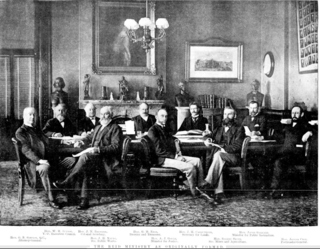Related Research Articles
Sydney-Cook was an electoral district of the Legislative Assembly in the Australian state of New South Wales, created in 1894 in inner Sydney from part of the electoral district of South Sydney and named after James Cook.

The Reid ministry was the 28th ministry of the Colony of New South Wales, and was led by the 12th Premier, George Reid. The title of Premier was widely used to refer to the Leader of Government, but was not a formal position in the government until 1920. Instead the Premier was appointed to another portfolio, usually Colonial Secretary but on this occasion Reid took the portfolio of Colonial Treasurer until July 1899 and then Attorney General.
Durham, an electoral district of the Legislative Assembly in the Australian state of New South Wales, was created in 1856 and abolished in 1859. It was recreated in 1880 and abolished in 1920.
The 1894 New South Wales colonial election was for 125 electoral districts, with each district returning one member. The election was conducted on the basis of a simple majority or first-past-the-post voting system. There were three significant changes from the 1891 election, the abolition of multi-member constituencies, the abolition of plural voting where an elector had property or residence in more than one electorate and that polls for every district were held on the same day. The number of seats was reduced from 141 to 125. In this election, in 74 electorates the winning candidate received less than 50% of the votes, while 1 was uncontested. The average number of enrolled voters per electorate was 2,046, ranging from Lismore (1,360) to Marrickville (2,924).
Kahibah, an electoral district of the Legislative Assembly in the Australian state of New South Wales, has had three incarnations, the first from 1894 to 1920, the second from 1927 to 1930 and the third from 1950 to 1971.
Belmore, an electoral district of the Legislative Assembly in the Australian state of New South Wales was created in 1904 and abolished in 1920.
Grenfell, an electoral district of the Legislative Assembly in the Australian state of New South Wales was created in 1880 and abolished in 1904.
Hartley, an electoral district of the Legislative Assembly in the Australian state of New South Wales had two incarnations, from 1859 until 1920 and from 1927 until 1968.
Sydney-King, an electoral district of the Legislative Assembly in the Australian state of New South Wales, was created in 1894 and abolished in 1904.
Sydney-Belmore, an electoral district of the Legislative Assembly in the Australian state of New South Wales, was created in 1894 and abolished in 1904.
Sydney-Denison, an electoral district of the Legislative Assembly in the Australian state of New South Wales, was created in 1894 and abolished in 1904.
Sydney-Bligh, an electoral district of the Legislative Assembly in the Australian state of New South Wales, was created in 1894 and abolished in 1904.
Sydney-Fitzroy, an electoral district of the Legislative Assembly in the Australian state of New South Wales, was created in 1894 and abolished in 1904.
Sydney-Flinders, an electoral district of the Legislative Assembly in the Australian state of New South Wales, was created in 1894 and abolished in 1904.
Sydney-Gipps, an electoral district of the Legislative Assembly in the Australian state of New South Wales, was created in 1894 and abolished in 1904.
Sydney-Lang, an electoral district of the Legislative Assembly in the Australian state of New South Wales, was created in 1894 and abolished in 1904.
Sydney-Phillip, an electoral district of the Legislative Assembly in the Australian state of New South Wales, was created in 1894 and abolished in 1904.
Sydney-Pyrmont, an electoral district of the Legislative Assembly in the Australian state of New South Wales, was created in 1894 and abolished in 1904.
West Sydney, an electoral district of the Legislative Assembly in the Australian state of New South Wales was created in 1859 and abolished in 1894.
Wickham, an electoral district of the Legislative Assembly in the Australian state of New South Wales was created in 1894 and abolished in 1920.
References
- ↑ Green, Antony. "Elections for the District of Sydney-Cook". New South Wales Election Results 1856-2007. Parliament of New South Wales . Retrieved 27 October 2020.
- ↑ Part 5B alphabetical list of all electorates and Members since 1856 (PDF). NSW Parliamentary Record. Parliament of New South Wales . Retrieved 27 October 2020.
- ↑ "Former Members". Members of Parliament. Parliament of New South Wales . Retrieved 27 October 2020.
- ↑ Green, Antony. "1901 Sydney-Cook". New South Wales Election Results 1856-2007. Parliament of New South Wales . Retrieved 30 March 2020.
- ↑ Green, Antony. "1898 Sydney-Cook". New South Wales Election Results 1856-2007. Parliament of New South Wales . Retrieved 8 April 2020.
- ↑ Green, Antony. "1895 Sydney-Cook". New South Wales Election Results 1856-2007. Parliament of New South Wales . Retrieved 9 April 2020.
- ↑ Green, Antony. "1894 Sydney-Cook". New South Wales Election Results 1856-2007. Parliament of New South Wales . Retrieved 11 April 2020.